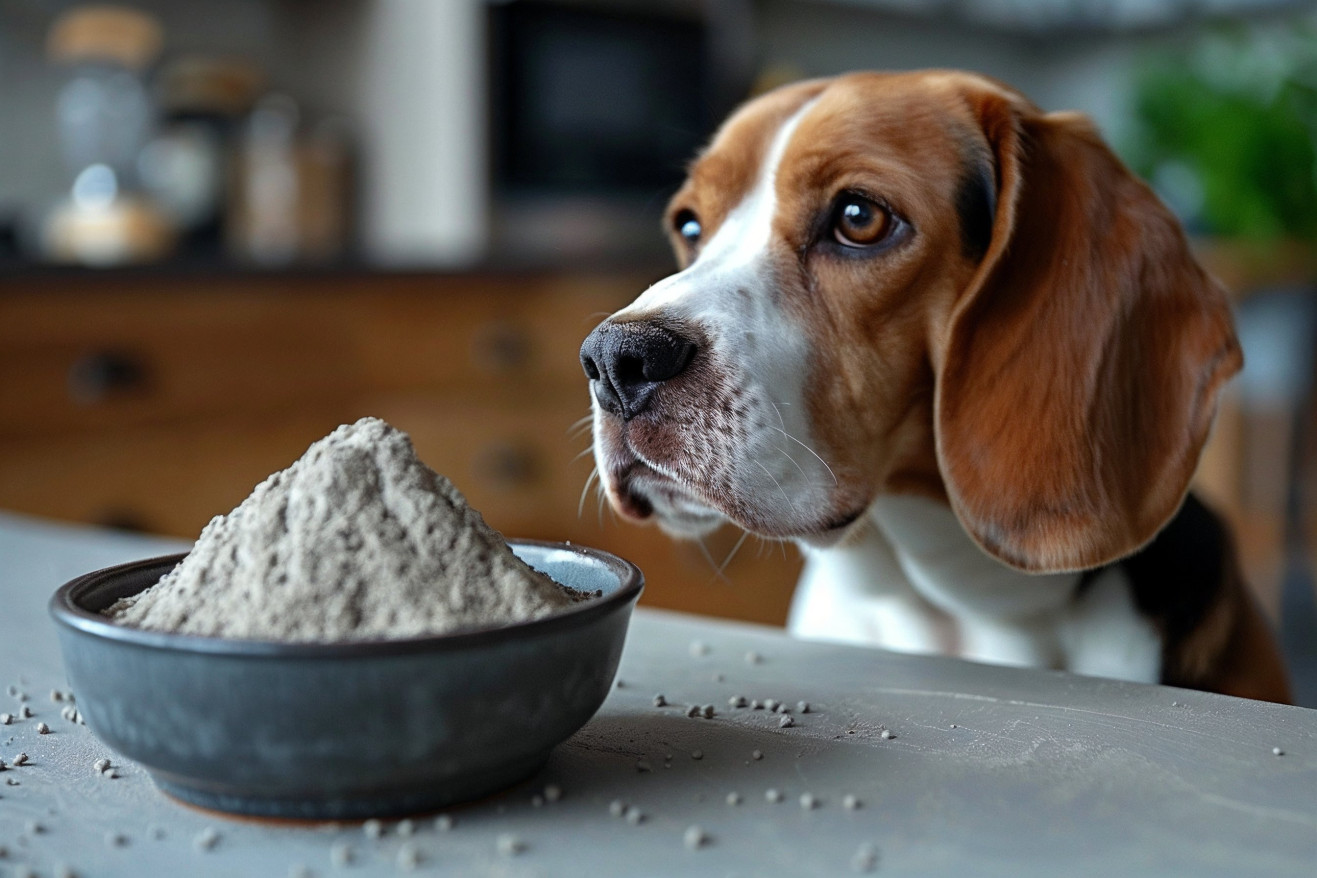Is Diatomaceous Earth Safe for Dogs? Uncovering the Facts
25 February 2024 • Updated 24 February 2024

Diatomaceous earth is often praised for its many uses, but is it safe for your furry friend? When used properly, food-grade diatomaceous earth is safe for dogs and can help with flea control and internal parasite management. However, it should not be inhaled or come into contact with the skin, eyes, or lungs to avoid irritation.
This article will provide an in-depth look at the safety of diatomaceous earth for dogs, drawing on research from veterinary medicine and toxicology to assess the potential benefits and risks. This thorough investigation will cover everything from how it’s used to the recommended doses and safety regulations to help you ensure that you can safely incorporate this natural substance into your dog’s wellness routine.
Is diatomaceous earth safe for dogs?
What to Know About Diatomaceous Earth for Dogs
Diatomaceous earth is a fine powder made from the fossilized remains of diatoms, a type of algae. While it is used in a variety of industries, Homes Alive Pets explains that it is of particular interest to dog owners because of its natural pest control properties and its use as a dietary supplement.
When used to control pests, diatomaceous earth works mechanically, not chemically—its microscopic, jagged edges pierce the exoskeletons of insects like fleas and ticks, causing dehydration and death without resorting to harsh chemicals.
When used as a supplement, diatomaceous earth is lauded for its mineral content and potential detoxifying effects. According to Dogs Naturally Magazine, it is rich in minerals and can help remove heavy metals from the body.
Despite these benefits, there are some myths about what diatomaceous earth can do and how safe it is. While it is non-toxic, it is important to make sure you are using food-grade diatomaceous earth to ensure it is safe and effective.
Diatomaceous earth is an alternative to traditional chemical pest control methods, but it may take longer to work because it doesn’t stop pest eggs from hatching.
However, it can be a healthy way to help your dog if you don’t want to use or can’t use traditional methods, as long as it is used responsibly and as directed. With its many uses and potential benefits, diatomaceous earth is a valuable addition to your dog’s health care.
Benefits of Diatomaceous Earth for Dogs
Diatomaceous earth is a popular natural solution for pest control, and it can be a non-toxic way for dog parents to protect their pets from fleas and ticks. When used as a dusting powder, food-grade diatomaceous earth dries out and kills fleas without the use of harsh chemicals, according to WebMD. This makes it especially useful for home use, where it can be used to kill pests on contact in carpets and pet bedding.
In addition, diatomaceous earth has been shown to have de-worming properties when ingested. Some dog parents believe that the sharp silica in diatomaceous earth can help rid dogs of internal parasites, which can help support digestive health. While there is limited scientific evidence to support this, the idea that diatomaceous earth works mechanically against parasites is an area that could be explored in future studies.
The FDA has recognized the safety and non-toxicity of food-grade diatomaceous earth when used as directed. This also applies to the potential benefits it can offer to a dog’s skin and coat health—although, like anything else, it should be used in moderation to avoid drying out the skin, according to The Labrador Site.
Many dog parents and some veterinarians have reported positive results anecdotally, indicating that diatomaceous earth can be a helpful part of a holistic pet care regimen. However, these benefits are best used in conjunction with professional advice to ensure that they don’t compromise a dog’s overall health and safety.
How to Manage the Dangers of Diatomaceous Earth for Your Dog
Even though there are potential benefits to giving your dog diatomaceous earth, it’s important to be aware of the dangers. According to PetMD, one of the most common side effects of inhaling diatomaceous earth is respiratory tract irritation, which can lead to coughing and difficulty breathing.
This is especially worrisome for dogs, who are more likely to inhale the substance due to their sniffing behavior. In addition, the National Pesticide Information Center reports that diatomaceous earth can cause skin, eye, and lung irritation in dogs if they come into contact with it.
One of the most important things to note is that food-grade diatomaceous earth is considered safe for consumption by the U.S. Food & Drug Administration, while non-food-grade diatomaceous earth can contain higher levels of harmful crystalline silica.
Non-food-grade diatomaceous earth has been linked to chronic lung disease and is classified as a Group 1 carcinogen if inhaled in high concentrations. While there are no widespread reports of negative side effects in dogs, the potential for respiratory irritation and other forms of irritation means that pet owners should be careful.
Veterinary professionals advise that pet owners should apply diatomaceous earth in a way that minimizes dust and the risk of inhalation. This means that pet owners should be careful when applying the substance and take into account environmental factors that could impact how the substance is dispersed.
As pet owners consider these factors, it’s important that they keep up with the latest veterinary research and regulatory information to make sure that they are protecting their pets.
Regulatory Standards and Expert Advice for Diatomaceous Earth in Dogs
The Food and Drug Administration (FDA) has set specific regulatory standards for diatomaceous earth in animal feed. According to the CFR—Code of Federal Regulations Title 21, diatomaceous earth can be used as an anticaking agent in animal feed, as long as it meets certain purity standards. These include a maximum lead content of 15 ppm, a maximum arsenic content of 20 ppm, and a maximum fluorine content of 600 ppm.
While food-grade diatomaceous earth is Generally Recognized as Safe (GRAS) for human consumption and as an anticaking agent in animal feed, it is not GRAS for pest control. In fact, the FDA has not approved diatomaceous earth for use as a parasite control in pets, and products that claim to do so have been the subject of regulatory action.
That said, many veterinarians are aware of the mechanical pest control properties of food-grade diatomaceous earth when it is used topically on dogs. The National Pesticide Information Center notes that while diatomaceous earth is not toxic, it can be drying and irritating to the skin. To avoid these effects, they advise minimizing skin and inhalation exposure.
While the FDA’s strict standards ensure the safety of diatomaceous earth in food, there is less clarity about its safety and effectiveness as a pest repellent. As a result, pet owners should work with veterinary professionals and adhere to expert advice to ensure they are using diatomaceous earth safely with their dogs, while also staying up to date on the latest regulatory standards and recommendations.
How to Apply Diatomaceous Earth to Dogs
If you decide to use diatomaceous earth on your dog, make sure you are using food-grade diatomaceous earth and follow the proper instructions to ensure safety.
Dogs Naturally Magazine suggests the following internal dosages for food-grade diatomaceous earth based on your dog’s weight: 1/2 teaspoon for small dogs and puppies, 1 teaspoon for dogs up to 50 pounds, 1 tablespoon for dogs over 50 pounds, and 2 tablespoons for dogs over 100 pounds. You can mix it in with your dog’s food to help with internal parasites.
To avoid dust and the potential for your dog to inhale it, make sure you are applying diatomaceous earth in a well-ventilated area and away from your dog’s face. Friends of the Dog also recommends wearing a mask and taking steps to make sure your dog doesn’t inhale the fine powder.
Make sure you are using diatomaceous earth regularly if you are using it to help with your dog’s parasites. For external parasites, The Labrador Site recommends lightly dusting your dog’s coat and then gently massaging the powder down to the skin, especially in areas where fleas are most likely to be found.
Keep an eye out for any adverse reactions in your dog, such as coughing or sneezing, which could be a sign of inhalation, or dry skin, which could be a sign that your dog needs a moisturizing bath. If you notice anything that concerns you or if you have any questions about how to apply diatomaceous earth, make sure you reach out to your vet.
Diatomaceous Earth for Dogs: A Word of Caution
While diatomaceous earth seems to be a promising way to protect your dog from pests, it’s important to remember that it’s not a cure-all. In fact, the American Kennel Club warns that diatomaceous earth can be dangerous to dogs if inhaled, and the Food and Drug Administration (FDA) has not approved it for use in parasite control.
The FDA’s lack of approval is especially concerning, as it suggests that the risks of diatomaceous earth may outweigh the benefits. In fact, the FDA has gone so far as to say that diatomaceous earth is not safe or effective for use in dogs and other pets.
In other words, while diatomaceous earth may be a good way to keep pests at bay, it’s not a substitute for other, more traditional methods of parasite control. As such, it’s best to use it in conjunction with other treatments, especially if your dog has a history of health issues.


